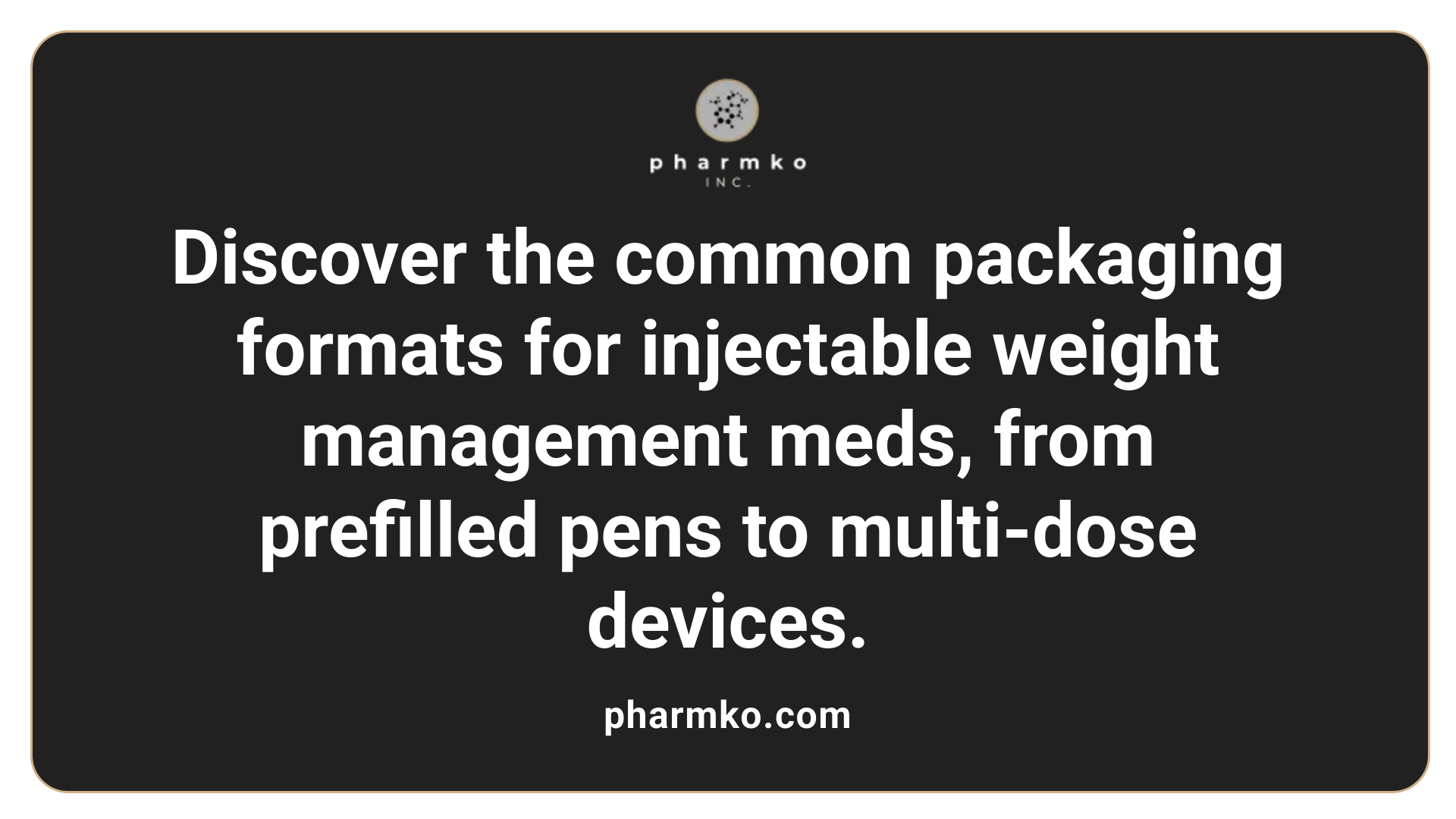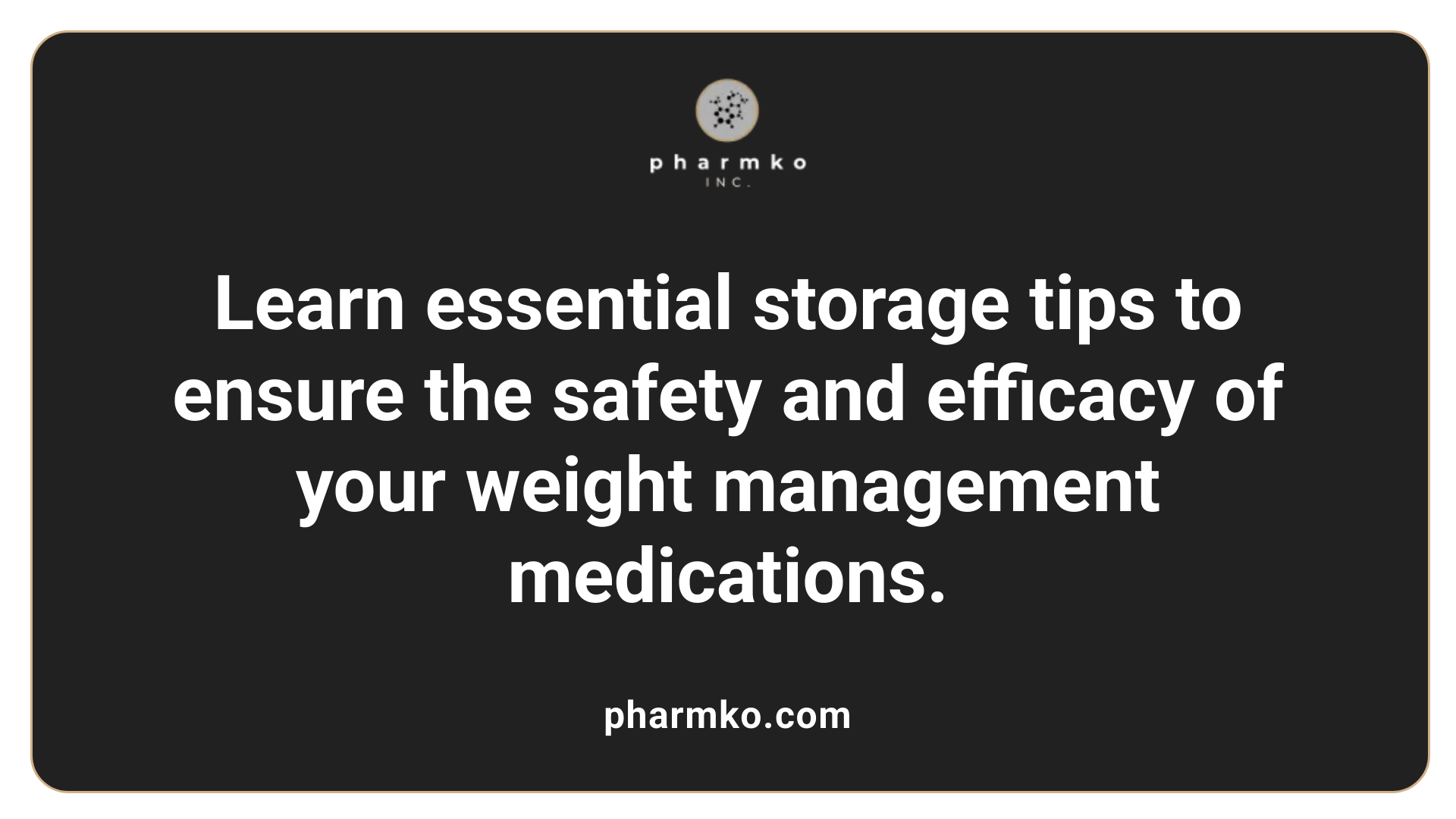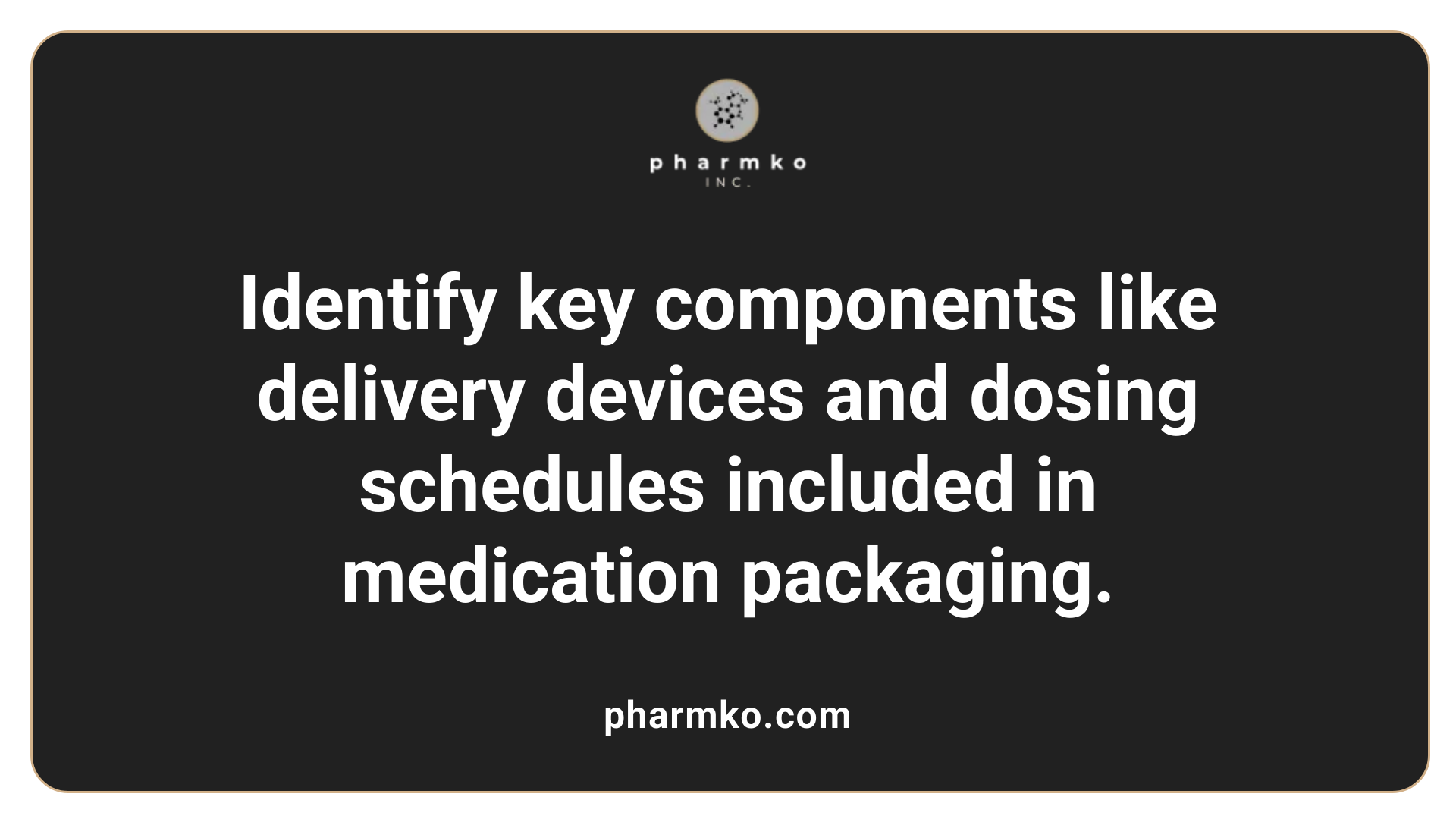How are weight management meds packaged?
Understanding How Weight Management Medications Are Packaged and Delivered
The packaging of weight management medications plays a crucial role in ensuring safe, effective, and convenient use. With the rise of injectable drugs like Wegovy and Saxenda, as well as oral options, various packaging methods are employed to meet safety standards, user convenience, and storage requirements. This article explores the diverse packaging practices, components, and considerations involved in delivering these medications to patients.
Packaging Methods for Injectable Weight Management Medications

What are the common packaging methods used for weight management medications?
Weight management medications are prepared with patient safety and ease of use in mind. Injectable treatments, such as GLP-1 receptor agonists like Wegovy, Saxenda, and Zepbound, are usually packaged in pre-filled syringes or pens. These devices are designed to deliver precise doses, whether weekly or daily, and often feature clear labeling to guide patients.
Many of these injectable medications come in single-dose prefilled pens, which simplify the process of self-administration. For example, Wegovy is supplied as a liquid solution in a prefilled, single-dose injection pen, making it convenient for weekly use. Such pens often include safety features to prevent accidental needle sticks and tampering.
In addition to pens and syringes, multi-dose injection devices exist that allow patients to administer several doses from one device, reducing waste and storage concerns. These may incorporate child-resistant safety features to prevent accidental injections by children, ensuring a higher safety standard.
For oral weight management medications like orlistat, the packaging typically involves blister packs or bottles containing tablets or capsules. These are designed for straightforward dosing, with markings and safety caps to avoid accidental ingestion or overdose.
Specific formulations such as Gelesis100 (Plenity) are packaged as pre-measured hydrogels in capsule form, intended for ingestion with water before meals. These capsules are individually sealed in blister packs, emphasizing safety and convenience.
While the details of packaging units are not always explicitly described, the overall design aims at ensuring ease of use, dosage accuracy, tamper resistance, and safety. This comprehensive approach helps patients manage their treatment effectively at home, sometimes supervised or initiated by healthcare providers.
Considerations for safe storage and handling
Proper storage of injectable medications involves keeping them refrigerated or at room temperature as recommended, protected from light and contamination. The packaging materials, such as tamper-evident seals and child-resistant caps, help maintain medication integrity and safety during storage and transport.
In conclusion, the packaging of weight management medications employs a variety of formats—pre-filled pens, syringes, capsules, and blister packs—each tailored to optimize safety, accuracy, and user convenience, essential for successful medication adherence.
Design and User Convenience of Packaged Medications

How are weight management medications presented and designed for user convenience?
Weight management drugs such as Wegovy and Zepbound are packaged in formats that prioritize ease of use and safety for the patient. For instance, these medications are housed in pre-filled injection pens or autoinjectors, which are designed for straightforward administration. These pens are often in single-dose formats, making weekly injections simple and minimizing dosing errors.
The packaging typically includes multi-dose pens that can be used over several weeks. These are housed in folding cartons or rigid cases that provide protection during storage and shipping. This ensures the medication remains stable and effective until use. Cold-chain solutions, like temperature-controlled shipping containers, are commonly employed to preserve the integrity of sensitive drugs such as semaglutide during transit.
Clear, large-font labeling is an important aspect of the packaging design. Labels display vital information, including the drug name, dosage, and safety warnings, with high contrast and minimal clutter to improve readability and prevent misuse. Easy-to-understand instructions are often included, promoting proper adherence.
For oral medications like Gelesis100, packaging involves capsules housed in bottles or blister packs, with instructions directly on the packaging—such as taking capsules with water before meals—to ensure proper administration.
Overall, the packaging of weight management medications combines functionality, safety, and environmental considerations. Manufacturers are increasingly using recyclable materials and expanding manufacturing facilities to meet the demand for sustainable packaging solutions. This approach supports not only patient safety and convenience but also environmental responsibility, aligning with contemporary healthcare packaging standards.
Storage and Handling Considerations

What are the storage and handling considerations for packaged weight management medications?
Proper storage of weight management medications is essential to ensure their effectiveness and safety. Injectable medications like Wegovy and Ozempic, which are supplied in prefilled, single-dose pens, typically require refrigeration at temperatures between 2°C and 8°C before opening. This refrigeration helps preserve the stability of the medication.
Once in use, some medications designed for weight loss, including Wegovy and Ozempic, can often be kept at room temperature—generally up to 30°C—for a limited period, such as 28 to 56 days. If stored at room temperature, they should be protected from direct sunlight, humidity, and extreme heat to prevent degradation. After the specified period, unused medication must be safely discarded.
Protection from light, moisture, and air is crucial for maintaining the drug’s potency. Containers should always be kept tightly closed when not in use and stored out of reach of children and pets.
Handling instructions for self-administration include careful use of the injection pens or devices, avoiding exposure to freezing temperatures or excessive heat. When traveling, patients should consider using insulated coolers to maintain proper temperature control.
Disposal procedures are equally important. Used needles, pens, and other sharps should be disposed of safely in designated sharps containers. Medications should not be flushed down the toilet unless explicitly instructed, to prevent environmental contamination. Instead, utilizing medication take-back programs or local disposal sites ensures environmentally friendly and safe disposal habits.
In summary, adhering to recommended storage and handling practices helps preserve medication efficacy, ensures safety during use, and protects the environment from potential contamination.
Safety and Regulatory Standards in Packaging

What safety and regulatory considerations are involved in the packaging of weight management medications?
The packaging of weight management drugs, including injectables like Wegovy and Zepbound, as well as oral options like capsules and tablets, must adhere to strict safety and regulatory standards. These standards are enforced primarily by the Food and Drug Administration (FDA), which oversees the safety, efficacy, and proper labeling of prescription medications.
Packaging materials are carefully selected to maintain the medication’s stability. For injections, packaging commonly involves prefilled pens or syringes that are designed to protect the medication from contamination, air, light, and moisture. These devices are meant for single or multiple doses, with clear instructions for use.
To prevent accidental poisoning, child-resistant features are mandatory. For example, injectable pens often come with safety caps or locking mechanisms, and oral medications are packaged in blister packs or bottles with child-resistant caps. These features are mandated under laws like the Poison Prevention Packaging Act, aimed at safeguarding children from unintentional ingestion.
Tamper-evident designs are another essential safety requirement. Packaging seals, shrink bands, or breakable caps are used to show if a product has been opened or altered. Such features provide consumers with confidence that the medication remained untouched during storage and transport.
Labeling is a crucial part of safe medication packaging. Labels must be clear and legible, providing proper dosage instructions, safety warnings, expiration dates, lot numbers, and storage information. This comprehensive labeling helps ensure correct usage and aids in tracking and recalls if necessary.
Furthermore, packaging operations follow rigorous procedures to avoid errors, cross-contamination, or damage. The entire process—from manufacturing to distribution—is closely monitored to comply with national and international regulations.
In summary, the standards for packaging weight management medications focus on safety, tamper-evidence, child resistance, and proper labeling. These measures collectively protect consumers and support effective, safe use of these medications.
| Aspect | Description | Regulatory Requirement |
|---|---|---|
| Packaging materials | Designed to preserve medication stability | Suitable for medication type and environment |
| Child-resistant features | Prevent accidental ingestion | Child-proof caps and blister packs |
| Tamper-evidence | Indicators of package tampering | Seals, shrink bands, breakable caps |
| Labeling | Clear instructions and safety info | Dosage, warnings, expiration, lot numbers |
| Compliance | Adherence to standards and laws | FDA, international regulations |
More information about these standards can be found through regulatory review documents and safety guidelines specified by the FDA and other health authorities.
Components Included in Packaging

What components are typically included in the packaging of weight management medications, such as dosing schedules or delivery devices?
Weight management medications, especially injectable forms such as Zepbound and Wegovy, are packaged to ensure safe and effective self-administration. The primary containers for these drugs are often prefilled syringes or pens, designed for user convenience and to preserve medication stability. For instance, Wegovy is supplied in a prefilled, single-dose injection pen, ready to use and PTW (push-to-wait) for weekly injections.
Many of these medications come with autoinjector devices or multi-dose pens that allow patients or caregivers to administer doses correctly. These delivery devices often include features such as dose selectors, safety locks, and clear markings to facilitate precise dosing and reduce errors. Accompanying accessories like detachable needles, alcohol swabs, and instructional leaflets are typically included in the packaging to guide users.
Dosing schedules are generally outlined in the instructions provided with the medication, indicating whether a patient needs weekly, biweekly, or daily injections, with specified amounts such as 15 mg or 5 mg doses. These are often printed on labels or in leaflets, ensuring the patient understands how often and how much to inject.
In addition to injection devices, some medications are packaged along with refrigeration requirements and safety features, such as tamper-evident seals and child-proof caps to prevent misuse.
Overall, packaging for weight management medications focuses on maintaining drug stability, supporting correct administration, and safeguarding patient safety, often providing clear, straightforward components suited to home use.
Reusability and disposal considerations
Many prefilled pens and syringes are designed for single use and should be disposed of properly in sharps containers after administration. Reusable devices may be cleaned according to manufacturer instructions, but specific disposal methods are critical to avoid needle-stick injuries and medication contamination.
Proper disposal guidelines are included with packaging, emphasizing the importance of safe handling and environmental considerations.
Variations in Packaging Across Formulations and Medications
How does packaging vary between different types of weight management medications or formulations?
Packaging for weight management medicines significantly depends on whether the drug is in oral or injectable form.
Oral medications, such as capsules or tablets, are usually packaged in blister packs or bottles. These containers are designed to protect the medication from moisture, light, and contamination. They often include clear dosing information and child-resistant features to ensure safety and ease of use. For example, drugs like orlistat come in capsule form, stored in bottles or blister packs that facilitate daily dosing.
Injectable medications, including drugs like Wegovy (semaglutide) or Zepbound, are supplied in pre-filled pens or vials. These devices are engineered to allow for precise dosing and easy administration, often with safety features like needle guards and tamper-evident seals. Pre-filled pens are convenient for weekly injections and are designed for straightforward use at home or in clinical settings.
The packaging for injectables typically considers proper storage conditions to maintain medication stability, which might involve refrigeration until use. Safety protocols include providing guidance on correct injection site rotation and proper disposal of used needles or pens.
In summary, while oral medications focus on protection and ease of swallowing with blister packs or bottles, injectable drugs emphasize safety, dosing accuracy, and ease of administration with pre-filled pens or vials. Both types aim to ensure medication stability and user safety, but their packaging shapes are tailored to their specific use and administration requirements.
Ensuring Safe and Effective Use Through Proper Packaging
The packaging of weight management medications is a critical component that influences safety, efficacy, and patient adherence. From pre-filled pens and syringes to blister packs and capsules, each format is designed to meet regulatory standards and patient needs. Effective packaging not only preserves the integrity of these medications but also enhances their safe and straightforward administration, supporting successful weight management efforts.
References
- Weight Loss Drugs & Injections: What Are Your Options?
- Are the New Weight Loss Drugs Too Good to Be True?
- Pharmacologic Treatment of Overweight and Obesity in Adults - NCBI
- Physician-supervised Options - Obesity Action Coalition
- Wegovy: Use for Weight Loss, Side Effects, Cost, and More
- Weight Loss Drugs & Injections: What Are Your Options?
- Phentermine: Package Insert / Prescribing Information - Drugs.com













